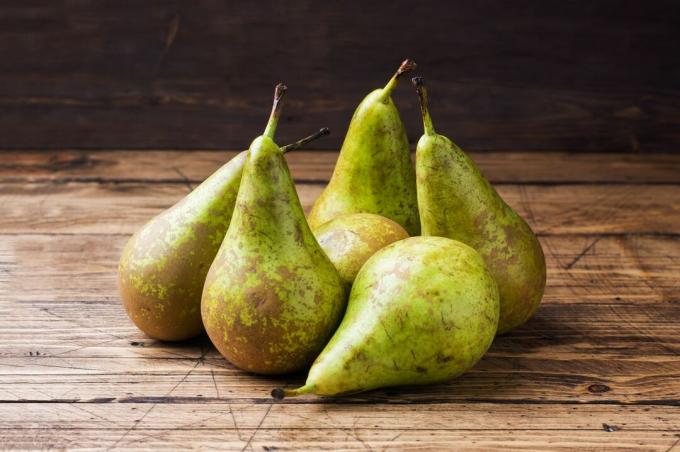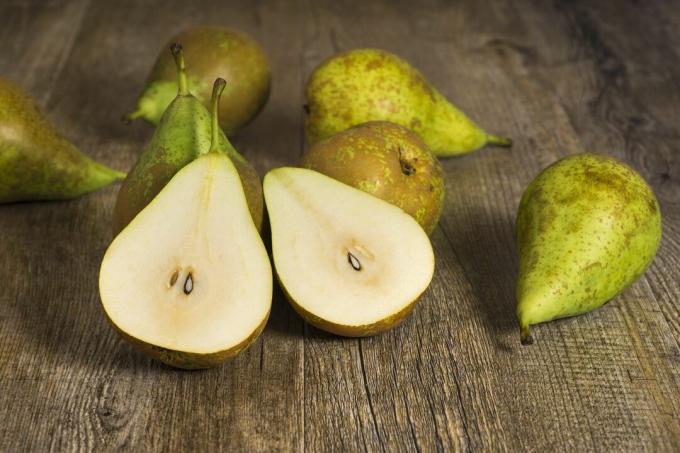The pear variety ‘Conference’ is an absolute classic among the fruit trees. We'll tell you how you too can soon be harvesting your own Conference pears.

The pear variety Pyrus communis "Conference", or Conference pear, is one of the most popular pear varieties in Europe. Its regular yield ensures that you can look forward to a tasty harvest with this variety every fall. We'll tell you how the Conference pears taste and how you can grow them in your own garden.
"Contents"
- Conference pear: profile
- Origin and history of the ‘Conference’ pear variety
- Properties and taste of the pear
- Plant and care for the pear tree ‘Conference’
- Pear ‘Conference’: Harvest time and use
Conference pear: profile
| fruit | medium-sized; green in color, yellow when fully ripe |
| taste | juicy, sweet with a pleasant acidity, light nutmeg aroma |
| Yield | regularly; tends to be fruity |
| Harvest time | from September / October |
| Ripe for enjoyment | October to early November |
| Shelf life | middle; Early harvested pears can be stored until the end of December |
| growth | medium strength |
| climate | also suitable for cool locations |
| Diseases and pests | robust against most diseases; easily susceptible to fire blight |
Origin and history of the ‘Conference’ pear variety
The pear variety ‘Conference’ has an exciting story to tell: In 1885 a conference was held in England to promote pear cultivation in England. More than 600 pears were presented at this conference, and the pear variety with the appropriate name for the event ‘Conference’ was particularly well received. That was the start of the triumphant advance of the pear variety from the breeder Thomas Francis Rivers. He selected the variety from seedlings from a free flowering of the mother variety ‘Léon Leclerc de Laval’. The "Conference" variety has been on the market since 1894. Today the conference pear is one of the most widely grown pear varieties in Central and Western Europe.
Properties and taste of the pear
The fruits of the Conference pear are medium-sized, have a slender and elongated shape and have a slight brown russeting. The fruits are green in color and turn yellow when fully ripe. In addition, the shell is pressure-resistant and is sometimes described as annoying when consumed.
The flesh of the Conference pear is salmon yellow with a gently melting structure. The enamel is even finer with the variety ‘Gellert's Butter Pear‘. The Conference pears are sweet and very juicy in taste, with a pleasant acidity and a slight nutmeg aroma.

Plant and care for the pear tree ‘Conference’
The ‘Conference’ is a variety with medium-strong growth. The growth rate is around 40 cm per year and the tree reaches a height of around four meters. If the variety is grafted on a base, the growth characteristics will of course differ. The variety shows medium to strong branching, which on the one hand regularly ensures fresh fruit wood, but on the other hand also increases the cost of cutting. The Conference pear is suitable for upbringing as a high stem, but even better as a half or low stem. Quince underlays can be used for finishing. The rootstock Quince C ’is weak, refinements with the rootstock Quince A’ and Quince Adams ’show medium to strong growth. For a more stable growth, you can also use new pear rootstocks, such as the rootstock ‘Pyrodwarf’ with medium-strong growth and the medium to strong-growing variety ‘OHF 333’.
What the optimal floor for your Conference pear looks like naturally also depends on the underlay used. In general, the ‘Conference’ feels good on nutrient-rich soils in full sun or partial shade. If the soil in your garden is not very rich in nutrients, it is advisable to ensure a good supply of nutrients with a predominantly organic fertilizer. When choosing a fertilizer, we recommend that you ensure that it has a good long-term effect, as with ours Plantura organic universal fertilizer.
The pear ‘Conference’ is considered a robust variety and is less susceptible to the most common pear diseases, such as pear scab. It shows a medium susceptibility to fire blight. In addition, due to its hardly pronounced susceptibility to wood frost, the variety is also suitable for cool locations.
In spring, the ‘Conference’ shows itself between April and May with bright white flowers, which have a low to medium sensitivity to frost. Since pears cannot self-pollinate, consider planting a pollinating variety nearby. The varieties ‘go particularly well with the pear variety‘ Conference ’Bosc's bottle pear‘, ‘Good Luise‘,‘ Delicious from Charneau ’, or‘ Williams Christmas pear ’.
One of the biggest advantages of the ‘Conference’ is its regular income. Since the pear tends to have an overabundance of fruit, this variety often has problems with small fruits. The tree can no longer adequately supply the mass of fruits and so the pears remain smaller and also have a poorer taste. Here, thinning out, i.e. removing excess fruit, can help to improve the quality of the fruit. If you have decided on a refined ‘Conference’ pear, you can count on the first tasty pears three years after planting.
If you want to plant a ‘Conference’ pear tree, spring is the ideal time for it. In the first few years after planting, you should think about annual maintenance pruning. The best time for the annual pruning is before budding from January to March.

Tip: Pear trees bloom up to 10 days earlier than apple trees. Because of the often cool and wet weather during flowering, pollination by honeybees is particularly difficult. They avoid cold and damp weather. Therefore, pear trees are particularly dependent on pollination by wild bees. You can prevent wild bees in your garden, for example, by creating a Flower meadow support financially.
Pear ‘Conference’: Harvest time and use
In autumn the time has come: the Conference pears will be ripe from September and October. Fully ripening is usually reached between October and the beginning of November, when the fruits are soft and the skin has turned yellow. But many like the pear a bit crisper. In this case, or if you want to store the pears, you should harvest the pears before the skin turns yellow.
The Conference pears are ideal for fresh consumption, the preparation of cakes or for preserving. If you harvest the fruits before they are fully ripe, the ‘Conference’ pear can be stored at refrigerator temperature until around the end of December. If harvested when fully ripe, the fruits are not suitable for storage, but must be consumed immediately.
For the orchard, the ‘Conference’ pear can be used very well with‘Bosc's bottle pear‘Can be combined, because the two varieties can be pollinated by each other's pollen.


